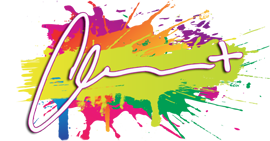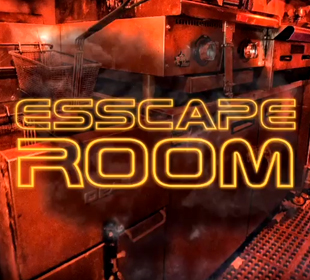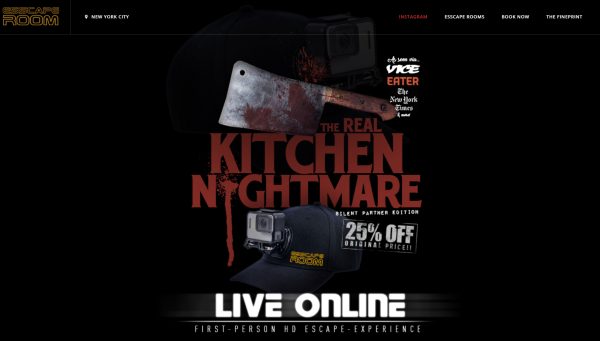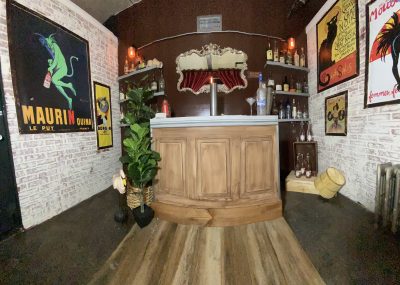RATING: 0 Keys RESULT: Win REMAINING: “survived”
I will have the spaghetti with a side salad. If the salad is on top, I send it back.
The Real Kitchen Nightmare is a remote play version of an existing, physical escape game at the venue’s brick and mortar location – retrofitted to be offered as a live, online experience. Although altered slightly to better flow in this new medium, the game is, at it’s core, essentially the same as what guests will find should they visit Esscape Room in person. To read our Pro-Tips on how to best enjoy this new Remote Play genre, click here.


Esscape Room crafts a fairly unique storyworld for The Real Kitchen Nightmare – at least at the beginning. Credit where it’s due, there are not very many restaurant kitchen themed games to be found – and for that reason alone, we were excited for the chance to remotely explore The Countess.
Beginning in the Speakeasy Bistro, would-be diners find a modest bar stocked for a party, yet left oddly vacant. Further into the venue, the large kitchen space sits equally abandoned. From there, though, The Real Kitchen Nightmare goes from unique theme to a bit of a disjointed mess. Seemingly forgetting the established mystery surrounding Chef Francois “Le Boucher” Hellerstein, Esscape Room makes up for lost time by having him go full-on serial killer. For some reason.
The Chef Hellerstein character could be portrayed with such nuance, establishing his motivations and perhaps even methods – but it doesn’t. Instead, it feels like a completely unrelated story is tacked on at the end, where the first two-thirds have nothing to do with murder and the finale has nothing to do with a restaurant. It probably should come as no surprise that there is no climax that resolves the narrative for those who “survive” The Real Kitchen Nightmare.

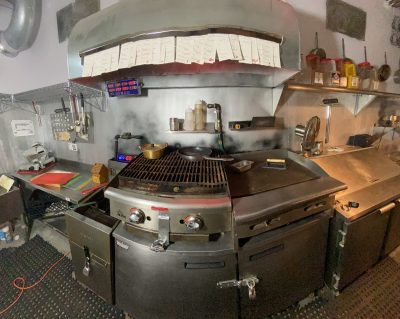 Beginning in The Countess’ speakeasy lounge, the scenic is modest as best. White brick-textured walls are lined with framed art, each decidedly devilish in flavor. The bar itself is quite small, though it is freshly stocked with alcohol bottles of various persuasion.
Beginning in The Countess’ speakeasy lounge, the scenic is modest as best. White brick-textured walls are lined with framed art, each decidedly devilish in flavor. The bar itself is quite small, though it is freshly stocked with alcohol bottles of various persuasion.
The kitchen space is the most impressive to be found within this game – but not specifically because Esscape Room went above and beyond, per se. What makes this second room “work” is the inclusion of actual, old, grungy kitchen equipment removed from a former NYC restaurant. A large grill and fryer dominate the space and draw your attention (whether the maître d’ wants you to see it yet or not.) Food orders clutter above the burners, and pots and pans line the shelves.
From the kitchen, would-be chefs find their way into “Le Boucher’s,” um, lair? A small room which feels vaguely “murder basement” serves as The Real Kitchen Nightmare’s disjointed final act – stained with over-exaggerated blood, chain link fence and a plastic toy rat.
Esscape Room does little to establish why this final room exists, or what drove Chef Hellerstein to apparently become a murderer. Maybe it was because his last name has “hell” in it?

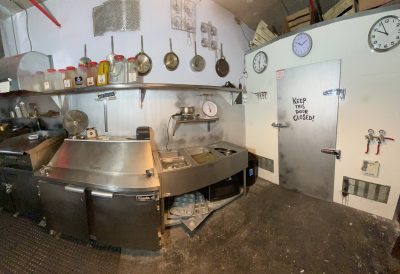 Right from the start, puzzles proved to be extremely problematic in The Real Kitchen Nightmare. To be clear, it’s not because they’re difficult; to the contrary, there’s not really anything particularly challenging to be found within this game. The first problem comes in the form of massive video lag – sometimes as much as twenty-five seconds.
Right from the start, puzzles proved to be extremely problematic in The Real Kitchen Nightmare. To be clear, it’s not because they’re difficult; to the contrary, there’s not really anything particularly challenging to be found within this game. The first problem comes in the form of massive video lag – sometimes as much as twenty-five seconds.
To be clear, the slowest internet speed among any member of our team is 100 mbps, with the fastest being 300 mbps – easily more than enough for live streaming. We found at different times throughout the game that one member of the team would locate a hidden object, ask the host to examine it, figure out its code and use it to open the lock before another member of the group even saw that object in the first place – through the very same live feed. Worse yet, this issue flip-flopped throughout the game – with the previously lagging connection jumping ahead, effectively swapping roles back and forth for who was having a terrible experience at any given moment. Even in the best case scenario, the video lag was so extreme that when giving the avatar verbal instructions, chefs may often find themselves wondering if he heard you, or if he’s even paying attention anymore.
That alone is enough to make any remote play game frustrating, but sadly it is the least notable of the detractors that The Real Kitchen Nightmare has going for it. Once in the kitchen, the game is somewhat non-linear, with puzzle tracks each comprising of several tasks leading to a key or code. In most cases, those tasks are very, very tedious. As mentioned already, none of the puzzles are difficult. Despite its marketing, we found The Real Kitchen Nightmare to be a not particularly challenging game; instead, its tasks are often slow, uninspired and tiresome.
One of the most critical design flaws an escape game can have is a lengthy puzzle track that leads players to an object which is – and has always been – freely available to find in the room from the start. Lengthy decoding and deciphering that leads simply to “look under the pot” is the perfect recipe to leave participants furious. After all, even the most novice of escape game player knows to search each new room that opens. If a key is just sitting inside of a cup on a shelf, they’re going to find it – and it’s a safe bet they’ll do so well before solving a lengthy, multi-step, tedious word-search that points them to it. It simply becomes an intentional waste of time.
Finding something like that even one time in a given game would be unacceptable. In The Real Kitchen Nightmare, it happens four different times.
One of those times, we directed the avatar to reach his hand into something we suspected would hold a key. He indicated there was nothing inside. Two more times over the course of twenty minutes, we sent him back to the same spot still expecting to find a key, and each attempt was met by similar claims of nothing to be found. After pointing our would-be maître d’ to the same exact spot three different times, guided by nothing more than common-sense searching, a combination of a lengthy math equation and letter by letter decoding of an entire sentence directed us to – you guessed it – look in that very location to find a freely available key.
The only way to make critically flawed puzzle flow worse is by openly lying to players who figure it out before you wanted them to do so.

We were excited to play The Real Kitchen Nightmare – especially because it came to us fairly hyped. We’d quickly learn, unfortunately, that not all hype is to be believed. In our humble opinion, after playing more than one hundred different Remote Play Games, Esscape Room remains solidly positioned as our least favorite.
This game could be good; in fact, it should be good. It has a unique theme and the foundations of an original story – at least at the start. But in our experience, it isn’t even close to good. Unfortunately, its terribly flawed puzzle flow – with not one but four moments of freely available objects serving as the prizes for multi-step, entirely tedious challenges is unacceptable. In one of those cases, the key that could be found through simple, entirely basic searching of the space would completely bypass the entire second room – wherein the majority of the game is intended to take place.
We also witnessed some concerns that could potentially verge on safety hazards in The Real Kitchen Nightmare. With the obvious caveat that we played this game online, we cannot speak with certainty to the texture or sharpness of a particular object. We’ll simply state that there appears to be several knives that, although clearly dulled down, still come to a pointed end. More uncomfortable – and not in a good way – is a key hanging from above, attached to a saw blade that appears to be real. But authentic or not, it does pose a concern in our opinion, by hanging above a player’s head – and obtained in such a way that it could be easy to drop (in fact, our avatar actually did accidentally drop it when we played.)
Despite the lofty reputations that surround The Countess, fine diners might find better served to take their business the local McDonald’s instead.
*Montu, Escape Authority’s VP, Dog Business™ and lead home game correspondent endorses the opinions found within this review.
Show your support for Escape Authority and get social with us:

Venue: Esscape Room
Location: Remote online play at home, broadcast live from Long Island City, NY
Number of Remote Games: 1
GAME SPECIFIC INFORMATION:
Duration: 60 minutes
Capacity: 6 people
Group Type: Private / You will not be paired with strangers.
Cost: $150 per group

We thank Esscape Room for inviting us to play this game. Although complimentary admission was generously provided, that in no way impacts the opinion included within this review.








